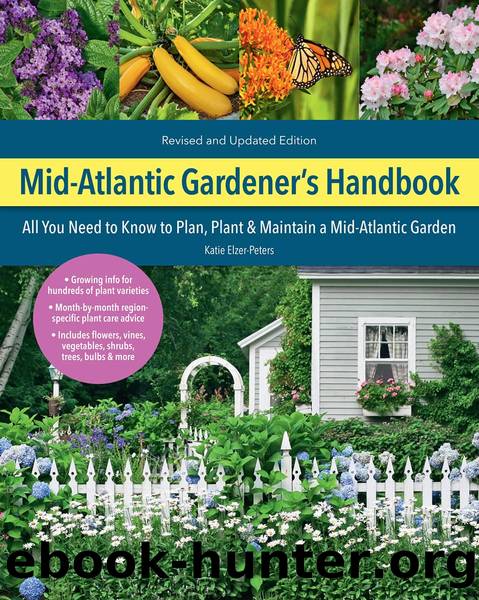Mid-Atlantic Gardener's Handbook, 2nd Edition by Elzer-Peters Katie;

Author:Elzer-Peters, Katie;
Language: eng
Format: epub
Publisher: Quarto Publishing Group USA
Published: 2021-03-15T00:00:00+00:00
ELDERBERRY
Sambucus spp.
WHY ITâS SPECIALâElderberries are large, early-summer-flowering shrubs that produce edible fruits (when processed). A few varieties have been developed for home gardens, especially ones with lacy leaves. Lemony Lace® (Sambucus racemosa) has finely dissected chartreuse leaves and looks like a Japanese maple. Black Lace® (Sambucus nigra) has similar leaves but in dark burgundy with pink flowers. Laced Up® (S. nigra) has dark, lacy leaves, and a compact, upright habit.
HOW TO PLANT & GROWâPlant in full sun to partial shade in moist soil. Because elderberries like to spread, plant in rain gardens, along low spots in the yard, and in areas where the plant can naturalize. Water to establish.
CARE & PROBLEMSâWater consistently to help the plant get established. It blooms on old wood, so if you need to prune, do so after flowering. Overly long branches also can be cut back during summer. Itâs deer resistant.
SEASONAL INTERESTâEarly summer, flowers; summer and fall, foliage
MATURE SIZE (H à W)â5â12 feet à 4â10 feet (depends on cultivar)
HARDINESSâZones 4â7
WATER NEEDSâMedium to high
NATIVE RANGEâEurope (S. nigra), Northern U.S. (S. racemosa)
Download
This site does not store any files on its server. We only index and link to content provided by other sites. Please contact the content providers to delete copyright contents if any and email us, we'll remove relevant links or contents immediately.
Turbulence by E. J. Noyes(7733)
The Thirst by Nesbo Jo(6473)
Gerald's Game by Stephen King(4391)
Be in a Treehouse by Pete Nelson(3662)
Marijuana Grower's Handbook by Ed Rosenthal(3524)
The Sprouting Book by Ann Wigmore(3424)
The Red Files by Lee Winter(3290)
The Remains of the Day by Kazuo Ishiguro(3153)
Sharp Objects: A Novel by Gillian Flynn(2859)
Christian (The Protectors Book 1) by L. Ann Marie(2610)
Organic Mushroom Farming and Mycoremediation by Tradd Cotter(2575)
The Culinary Herbal by Susan Belsinger(2343)
Stone Building by Kevin Gardner(2300)
Lilac Girls by Martha Hall Kelly(2210)
The Starter Garden Handbook by Alice Mary Alvrez(2210)
The Unlikely Pilgrimage of Harold Fry by Rachel Joyce(2143)
The Lean Farm Guide to Growing Vegetables: More In-Depth Lean Techniques for Efficient Organic Production by Ben Hartman(2014)
Urban Farming by Thomas Fox(1990)
Backyard Woodland by Josh VanBrakle(1838)
